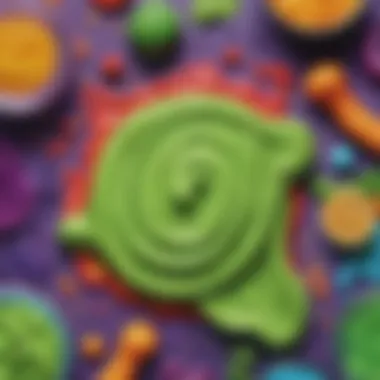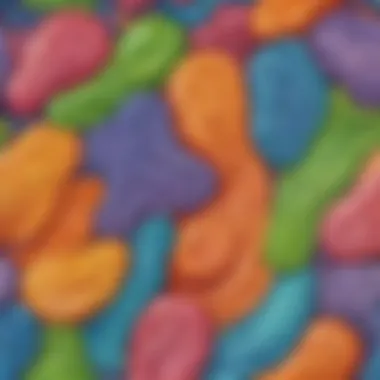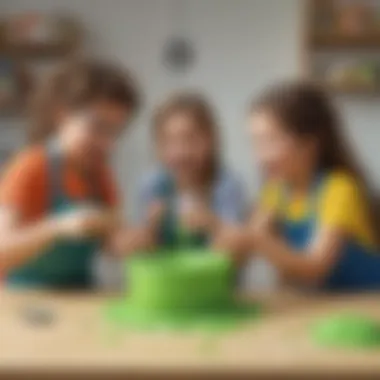Discover the Essential Ingredients for Making Vibrant Slime Creations


Science Fun Facts
In the world of slime-making, did you know that borax can act as a popular activator for creating that perfect slimy consistency? It's fascinating how just a few drops of this substance can transform a glue mixture into a stretchy and delightful gooey creation. Another fun fact is that different types of slime can be achieved by adjusting the quantities of certain ingredients like water and activator, leading to a spectrum of textures from runny to jiggly.
Discover the Wonders of Science
- Exploring the Chemical Reactions Behind Slime
- Educational Benefits of Sensory Play
- How Different Temperatures Affect Slime Texture
- Real-Life Applications in Materials Science
Science Quiz Time
Let's test your slime-making knowledge! Which of the following is an essential ingredient for creating slime? A) Flour B) Glue C) Sugar D) Salt
Science Experiment Showcase
Introduction to Slime Components
Before embarking on your slime-making journey, let's delve into the key materials required. Firstly, glue serves as the primary base for slime, providing the viscous foundation essential for creating that satisfying stretch and pull. Activators such as borax or saline solution are crucial elements that interact with the glue molecules, causing them to crosslink and form the desired texture. Incorporating a colorant adds a whimsical touch to slime, allowing for vibrant and eye-catching creations.
Safety First: Tips for Responsible Slime Making
When engaging in the art of slime creation, safety should always be a top priority. Ensure that children have adult supervision during the process, especially when handling any activators or chemicals. Avoid ingesting or getting slime in contact with eyes or mouth, as some ingredients may cause irritation. Additionally, it's advisable to wash hands thoroughly after playing with slime to prevent any potential skin reactions.
Enhancing the Sensory Experience with Texture Play
Experimenting with slime opens up a world of sensory exploration for children. By manipulating the ingredients' ratios and exploring different mixing techniques, young minds can observe firsthand how texture changes affect the slime's properties. Encourage tactile play by varying the level of stickiness or stretchiness in the slime, fostering sensory development and creative expression.
Crafting Customized Slime Creations
As individuals engage in the creative process of making slime, they have the opportunity to personalize their creations through experimentation and innovation. Whether opting for glitter, foam beads, or scent additives, each addition contributes to a unique sensory experience. By encouraging imaginative exploration and hands-on discovery, slime-making becomes a dynamic platform for self-expression and scientific inquiry.
Slime-making has become a popular sensory activity for children, offering a perfect blend of fun and creativity. This article delves into the essential ingredients and tools required to create this intriguing concoction. Exploring the world of slime opens up endless possibilities for young minds to engage in hands-on experimental learning, making it a truly enriching experience.
Understanding the Basics
What is slime?


Slime is an intriguing substance that exhibits both liquid and solid properties. Its unique characteristic of fluidity while maintaining its shape intrigues many young learners. Slime serves as an excellent medium for sensory play, igniting curiosity and creativity in children. The hands-on experience of creating and manipulating slime encourages scientific exploration and experimentation.
Importance of following a recipe
Following a slime recipe meticulously is crucial to achieve the desired consistency and texture. Each ingredient plays a specific role in determining the final outcome of the slime. By adhering to the recipe, children not only hone their measuring skills but also learn the importance of precision in scientific processes. The significance of following a recipe extends beyond just slime-making, instilling valuable lessons of discipline and attention to detail in young minds.
Safety Precautions
Parental supervision
Parental supervision is paramount during slime-making activities to ensure a safe and enjoyable experience for children. Monitoring the ingredients used and guiding the process helps in preventing accidents and mishaps. Engaging in slime-making under parental guidance also fosters bonding and creates opportunities for quality time spent together.
Proper ventilation
Maintaining proper ventilation in the workspace is essential when making slime. Some ingredients used in slime-making, such as glue and activators, may emit fumes that can be irritating. Adequate airflow reduces exposure to these fumes, creating a safe environment for both children and adults. Prioritizing ventilation not only enhances safety but also ensures a comfortable and pleasant slime-making experience for all involved.
Essential Ingredients
In the world of slime-making, essential ingredients form the backbone of any successful concoction. These components are not just random additives; they are the building blocks that determine the final texture, stretchiness, and overall sensory experience of the slime. From glue to activators, each ingredient plays a pivotal role in the chemical reaction that transforms a few simple substances into a colorful and squishy creation. Understanding the importance of these essential ingredients is key to mastering the art of slime-making and unleashing your creativity to concoct different variations and textures that will captivate young minds.
Glue
When it comes to slime, glue is like the foundation of a building - crucial for creating the right consistency and stretchiness. There are two main types of glue commonly used in slime recipes: clear glue and white glue. Clear glue is known for its transparent appearance, adding a glossy sheen to the slime while allowing any added color or glitter to shine through vividly. On the other hand, white glue is a versatile option that serves as a base for various colored slimes and can easily be found in most households. Each type of glue brings its unique characteristics to the slime-making process, offering different textural outcomes based on personal preferences and desired end results.
Clear Glue
Clear glue stands out for its see-through quality, which enhances the visual appeal of the slime by creating a crystal-clear finish. This type of glue is favored for creating transparent or translucent slimes that showcase any added colors, beads, or sequins brilliantly. Its adhesive properties ensure that the slime maintains its stretchiness and elasticity, making it an ideal choice for those aiming for a sleek and shiny slime texture. While clear glue is a popular option for crafting visually striking slimes, it may require more careful handling in comparison to white glue due to its transparency.
White Glue
White glue is a staple in the world of slime-making for its versatility and accessibility. This type of glue serves as a neutral base that readily accepts colorants and additives to produce a wide range of slime variations. White glue is loved for its ease of use and availability in most craft stores or even regular supermarkets, making it a convenient choice for beginners or seasoned slime enthusiasts alike. Its opaque nature allows for vibrant colors and textures to shine in any slime creation, providing endless possibilities for customizing the slime to suit individual preferences and creative visions.
Activator
Activators play a vital role in slime-making by facilitating the chemical reaction between the glue and other additives to create the desired consistency and stability in the slime. Two common activators used are borax solution and contact lens solution. These components act as catalysts that bind the molecules of the glue together, transforming it from a sticky liquid into a stretchy and moldable substance that defines the characteristics of the final slime texture. Understanding the properties of activators is crucial in achieving the perfect slime consistency that is not too sticky or too stiff, ensuring an enjoyable sensory experience for both kids and adults alike.
Borax Solution


Borax solution is a traditional activator that has been long used in slime recipes for its effectiveness in creating a firm and stretchy slime texture. By mixing borax powder with water, a solution is formed that acts as a cross-linking agent, binding the molecules of the glue to form a cohesive and moldable slime. This activator is preferred for its ability to produce slimes with good elasticity and durability, making it a popular choice among slime enthusiasts seeking a reliable and budget-friendly option for creating various slime textures.
Contact Lens Solution
Contact lens solution has emerged as a popular alternative activator for slime-making, especially for those seeking a borax-free recipe or having sensitivities to borax. This solution contains boric acid, which reacts with the glue to create a similar cross-linking effect that results in a stretchy and pliable slime texture. Contact lens solution is praised for its accessibility and ease of use, as it can be found in most pharmacies or supermarkets. Its gentle formula offers a safer option for making slime, particularly for young children or individuals with skin sensitivities, ensuring a fun and worry-free slime-making experience for all involved.
Coloring Agents
Coloring agents add a creative and vibrant touch to slimes, allowing makers to personalize their creations with a rainbow of hues. Two popular coloring agents used are food coloring and glitter, each providing a different visual effect to the slime. By choosing the right colorants, makers can transform their slime into a work of art that exhibits their unique style and preferences, making the sensory play experience both visually appealing and engaging for young minds.
Food Coloring
Food coloring is a versatile coloring agent that comes in liquid or gel form, offering a wide spectrum of colors to customize slime creations. This coloring option is ideal for achieving solid, pastel, or vivid shades, depending on the desired outcome. Food coloring blends easily into the glue, allowing users to experiment with different color combinations and layering techniques to create mesmerizing color patterns in their slimes. Its non-toxic nature makes it a safe choice for adding vibrant colors to slimes that are both eye-catching and charming, sparking creativity and imagination in kids of all ages.
Glitter
Glitter adds a touch of sparkle and glamour to slimes, transforming them into dazzling creations that captivate the eyes and imagination. This additive comes in various sizes and colors, allowing makers to customize the level of shimmer and shine in their slimes. Whether used sparingly for a subtle glimmer or generously for a full-on sparkle effect, glitter elevates the visual appeal of slimes, making them glisten and sparkle with every stretch and squeeze. Glitter is a popular choice for those looking to create magical and enchanting slimes that shimmer in the light, adding a touch of whimsy and charm to the sensory play experience.
Optional Add-Ins
In the realm of slime-making, Optional Add-Ins stand out as crucial elements that elevate the sensory experience for creators. These additional components go beyond the essential ingredients, offering a realm of creativity and customization to each batch of slime. By incorporating Optional Add-Ins, such as scented oils and texture enhancers, children can personalize their slime to suit their preferences and engage in further experimentation and exploration.
Scented Oils
Lavender oil:
Lavender oil plays a significant role in the sensory experience of slime-making. Its subtly floral aroma adds a calming and soothing element to the overall tactile sensation. The key characteristic of Lavender oil lies in its ability to promote relaxation and sensory stimulation simultaneously, making it a preferred choice for those seeking a multi-sensory play activity. The unique feature of Lavender oil is its natural calming properties, which contribute to a therapeutic and enjoyable slime-making process. While Lavender oil enhances the sensory experience, some may find its scent too overpowering, so it's advisable to use it in moderation to avoid overwhelming the olfactory senses.
Peppermint oil:
Peppermint oil brings a refreshing and invigorating twist to slime-making, enriching the sensory journey with its minty fragrance. The key characteristic of Peppermint oil lies in its ability to energize and uplift the mood, offering a revitalizing element to the overall play experience. Its unique feature is the cooling sensation it provides, which can add a refreshing tingle to the slime texture. Peppermint oil is a popular choice for its rejuvenating properties, injecting a burst of freshness into the slime. However, excessive use of Peppermint oil may lead to an overwhelming scent, so moderation is key to strike a balance in creating an enjoyable sensory environment.
Texture Enhancers
Foam beads:
Foam beads introduce a textural dimension to slime, transforming the consistency into a crunchy and satisfying tactile experience. The key characteristic of foam beads lies in their ability to add a delightful crackle and crunch to the slime, enhancing the overall sensory engagement. Their unique feature is the lightweight and airy texture they bring, creating a distinctive feel within the slime. Foam beads are a popular choice for their ability to create a unique sensory experience, but they may pose a choking hazard for young children if not handled carefully, requiring parental supervision during playtime.


Floam balls:
Floam balls offer a playful twist to slime, infusing the texture with bouncy and resilient spheres that add a fun element to the sensory exploration. The key characteristic of Floam balls lies in their ability to provide a squishy and moldable texture, enhancing the interactive and hands-on qualities of the slime. Their unique feature is the resilience and shape retention they offer, ensuring prolonged enjoyment and manipulation. Floam balls are a beneficial choice for their interactive nature, fostering imaginative play and creative expression. However, due to their small size, supervision is essential to prevent accidental ingestion and ensure safe play.
Tools and Equipment
Unquestionably, the section on Tools and Equipment holds paramount significance in this insightful article aiming to illuminate the readers about the necessary paraphernalia for creating slime effortlessly and safely. When embarking on the adventure of slime-making, one must not overlook the pivotal role that various tools and equipment play in ensuring a smooth and successful crafting process. From facilitating the mixing of ingredients to providing efficient storage solutions, the tools and equipment are indispensable companions in the artistic journey of slime creation.
Mixing Bowls
Resting at the core of the slime-making process, mixing bowls form the foundational element essential for blending the ingredients seamlessly. Plastic bowls stand out as a popular choice among slime enthusiasts owing to their durability and ease of cleaning. These bowls come in various sizes, accommodating different batch measurements, and their smooth surfaces make stirring and mixing a hassle-free experience. On the other hand, stirring sticks are indispensable tools that aid in achieving the desired consistency of the slime mixture. Their elongated design enables efficient mixing, ensuring that all components are harmoniously combined to produce a homogeneous slime texture.
Plastic Bowls
Plastic bowls play a crucial role in the slime-making endeavor, offering a versatile and convenient vessel for amalgamating the key ingredients effectively. The lightweight nature of plastic bowls makes them easy to handle, especially for young slime enthusiasts eager to embark on their creative journey. Additionally, the flexibility of plastic bowls allows for effortless maneuvering during the mixing process, contributing to an enjoyable and stress-free slime-making session.
Stirring Sticks
The unassuming yet essential stirring sticks hold a significant position in the realm of slime creation, enabling enthusiasts to achieve the desired consistency and texture of their slime effortlessly. With a slender and elongated design, stirring sticks facilitate thorough mixing of the ingredients without introducing unnecessary air bubbles, ensuring a smooth and uniform slime composition. The smooth and non-porous surface of stirring sticks prevents residue build-up, guaranteeing a hygienic and effective mixing experience for all slime crafters.
Storage Containers
While embarking on the exciting journey of slime-making, the significance of storage containers cannot be overstated. Storage containers play a dual role in safeguarding the freshly crafted slime and preserving its quality for prolonged enjoyment. Air-tight jars emerge as a popular choice for storing slime, providing a secure seal that prevents air exposure and maintains the desired consistency of the slime. On the other hand, ziplock bags offer a convenient and portable storage solution, allowing slime enthusiasts to store their creations with ease and precision.
Air-tight Jars
The reliable and efficient air-tight jars offer a safe haven for freshly made slime, ensuring its longevity and quality are preserved. The impermeable seal of air-tight jars prevents moisture loss, retaining the elasticity and texture of the slime for extended periods. Their transparent design allows for easy monitoring of the slime's condition, giving creators the peace of mind that their artistic endeavors are well-protected and ready for future play sessions.
Ziplock Bags
Ziplock bags present a versatile and practical storage option for slime aficionados seeking convenience and space-efficient solutions. The resealable feature of ziplock bags enables easy access to the stored slime while maintaining a secure closure to prevent any leaks or contamination. With their flexible structure and compact design, ziplock bags are ideal for organizing and storing slime creations, making them a valuable storage companion in the world of homemade slime.
Measuring Tools
In the realm of slime-making precision, accuracy, and consistency are key, underscoring the vital role of measuring tools in achieving the perfect slime concoction. Measuring cups, renowned for their standardized units, ensure that ingredients are proportioned correctly, laying the groundwork for a successful slime creation session. On the other hand, spoons serve as versatile measuring instruments, offering flexibility in ingredient quantities and promoting meticulous craftsmanship in the art of slime-making.
Measuring Cups
Essential for achieving precision in ingredient measurement, measuring cups play a fundamental role in the slime-making process, granting creators the assurance of accurate proportions. With clearly marked measurements, measuring cups enable enthusiasts to follow recipes diligently and experiment with different ingredient combinations confidently. The sturdy construction of measuring cups ensures durability and longevity, making them reliable companions for countless slime-making adventures.
Spoons
Versatile and practical, spoons serve as indispensable measuring tools in the creative pursuit of crafting slime, offering flexibility and ease of use for slime enthusiasts. Whether measuring liquids or powders, spoons provide a convenient solution for dispensing precise ingredient quantities, catering to the unique requirements of individual slime recipes. The varying sizes of spoons allow for versatile usage, accommodating both large and small ingredient measurements with accuracy and ease.







